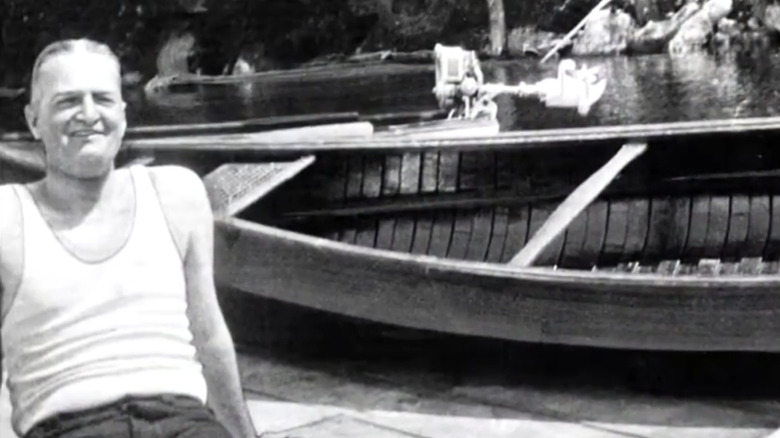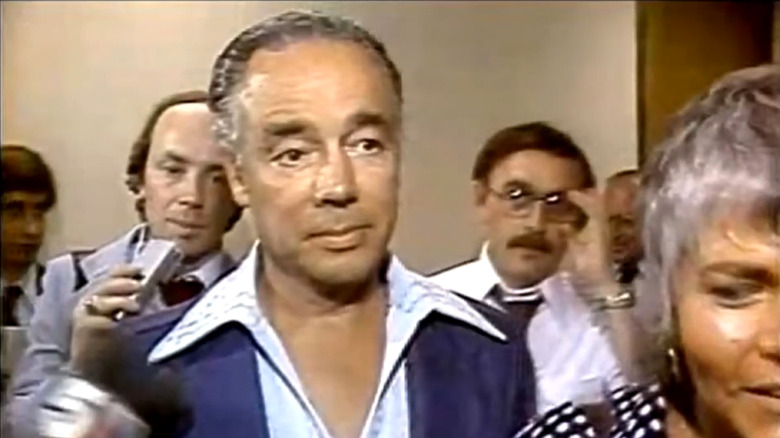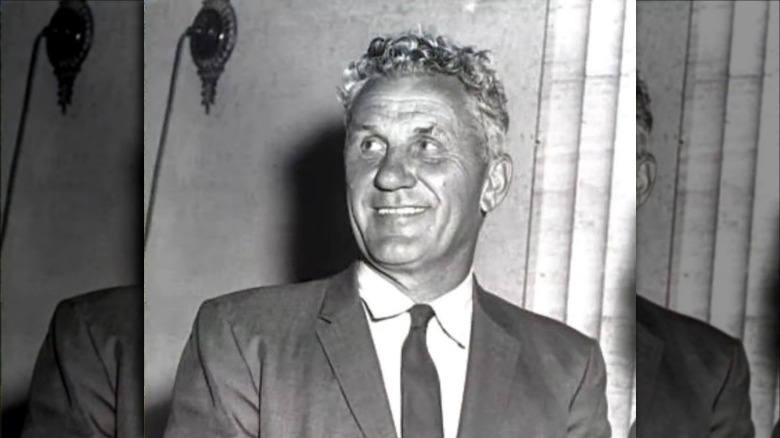The Mysterious Disappearance Of Helen Brach The Candy Lady
Watch enough true crime documentaries or listen to enough true crime podcasts and you'll get the impression that most crimes are solved relatively quickly. Someone dies, someone goes missing, and everyone more or less knows what happened within a few days or weeks.
The reality is much different. The U.S. Department of Justice reports there were more than 250,000 unsolved murders on the books in 2019 — with thousands more being added every day. And, according to the FBI, in 2020 alone there were 543,018 missing persons cases in the U.S., of which nearly 90,000 were active.
In this context, it shouldn't be too surprising that a woman named Helen Brach went missing in 1977, and that the case has never been closed. Helen was the widow of Frank Brach, heir to the Brach candy fortune. She was a member of a well-known family and a multi-millionaire when she vanished. But all of her money and influence couldn't help locate her or solve what is one of the twistiest crime stories of the 20th century. Here's what we know about the mysterious disappearance of Helen Brach, the "Candy Lady."
Helen Brach married into money
According to "Silas Jayne," Helen Vorhees wasn't born rich. She married relatively young, had no children, and was soon divorced. "Hot Blood" reports that Vorhees then moved to Florida to escape her family and to get better job prospects, eventually working as a receptionist and hat-check assistant at the Indian Creek Country Club.
That's where she met Frank Brach, heir to the Brach candy fortune, just after World War II. Criminal Element notes that at one point the E.J. Brach & Sons company sold two-thirds of the candy in the U.S., and when Frank sold the company in 1966 he got $136 million for it, which would be equivalent to more than $1 billion today.
When Frank and Helen met, he was still married to his second wife, June, but the couple were already in the process of separating. June accused Helen of having an extramarital affair with Frank in the divorce proceedings. According to ABC7 Chicago, Frank married Helen in 1950, transforming her into a member of high society. Helen and Frank had more in common than was obvious: although Frank was now fantastically wealthy, he'd lived much of his childhood in relative poverty.
According to the Chicago Tribune, Helen and Frank's 20-year marriage was a happy one, and when Frank died in 1970, he left Helen with most of his wealth.
Helen Brach vanished into thin air
Perhaps the most remarkable aspect of the Helen Brach story is how she seemingly vanished into thin air. The Chicago Tribune reports that Helen traveled to the Mayo Clinic in Rochester, Minnesota in February, 1977. She was there for a routine physical. The last time a reliable witness saw her was when she purchased a gift in a shop at the hospital. According to Criminal Element, the cashier at the shop recalls her saying "Please hurry and finish wrapping. My houseman is waiting," which the cashier took to mean Helen's driver was waiting for her. Helen Brach, one of the richest women in the country at the time, left the shop and was never seen again.
ABC7 Chicago reports that Helen's houseman, Jack Matlick, claimed he picked up Helen at Chicago's O'Hare airport when she returned from Rochester and drove her home. But "Hot Blood" explains that no one on the flight crew that day could recall seeing her. According to Matlick, Helen stayed home for four days, spoke to no one, and then he drove her back to the airport to travel to Florida — but she never arrived.
The houseman had a record
One of the key elements to understanding Helen Brach's disappearance is knowing how much she relied on her houseman, Jack Matlick. According to Criminal Element, Matlick was hired by Helen's husband Frank in 1959 to work as a chauffeur and a handyman. When Frank passed away, Helen relied on him even more, making him responsible for the upkeep of her main residence.
ABC7 Chicago reports that Matlick claimed he picked up Helen at O'Hare airport on February 17, 1977. He said he took her home, where she stayed inside for four days, seeing no one and making no phone calls. Even a group of painters working at the house saw no evidence that she was home. Then Matlick claimed he drove Helen back to the airport, where she got on a plane to Florida — but none of her friends in Florida knew she was coming or saw her there.
What Frank probably didn't know when he hired him is that Matlick had a criminal record, including aggravated robbery. Matlick was also reportedly abusive towards his wife. The man who Helen was frequently alone with and who she relied on for just about everything was a criminal, and possibly a violent one at that.
Some think the butler did it
Jack Matlick is a popular suspect in the disappearance of Helen Brach for several reasons. First, Matlick claimed to have picked up Helen in Chicago on the day she vanished, then driven her home, and then driven her back to the airport four days later. No one else saw her during this period of time. Friends apparently stopped by the house, but were sent away by Matlick, who said Helen was unwell.
Second, as noted by Criminal Element, Helen's gardener claimed to have seen Matlick at Helen's home during those four days, in the company of two suspicious-looking strangers. Matlick also reportedly engaged in a lot of very suspicious cleaning at the house — according to OrangeBean Indiana, he had two rooms painted, the carpet in one room replaced, and Helen's Cadillac detailed during this time. Third, Matlick had a toll receipt suggesting that he'd driven to a remote farm owned by Helen (via The Criminal Element).
Finally, as noted by ABC7 Chicago, Matlick admitted to forging Helen's signature on checks totaling $13,000. He also admitted stealing $75,000 in cash from the house, and The Criminal Element says that he gave up a $50,000 bequest in her will in order to make those charges go away. Perhaps most chillingly, he also reportedly ordered a meat-grinder attachment during this time.
Helen Brach's brother acted suspiciously
Helen Brach's driver and handyman, Jack Matlick, claimed to have been the last person to see her alive when he picked her up from the airport in February, 1977. But, as reported by Criminal Element, he didn't bother to report her missing for two weeks. According to the Washington Post, when Matlick finally did make the call, the police informed him that only a member of her immediate family could file a missing person's report under state law.
Matlick dutifully tracked down Helen's brother, Charles. Charles was living in Ohio, and his reaction to the news that his wealthy sister was missing was somewhat odd. First, he didn't rush to Illinois in concern for his sibling. Instead, he seemed to feel zero urgency, and told Matlick that he couldn't travel to him until the end of the week. Second, when he finally did manage to make the trip, he asked Matlick to help him destroy some of Helen's personal papers, including burning her diary, before he went to the police to officially report her missing.
In the end, Charles was probably the only person who could have pushed authorities to keep investigating. Instead, he seemed happy to have the police give up, and no significant progress was made in Helen's case for nearly 20 years.
Helen Brach fell victim to a gigolo
When Frank Brach died in 1970, Helen Brach was 59 years old. As a widow with no children, perhaps it's not surprising that she was happy to meet a man who seemed to take a romantic interest in her. Unfortunately, that man was a guy named Richard Bailey.
According to the Washington Post, Bailey was a gigolo and a con man who targeted "women who were alone in life." Bailey was connected to the incredibly corrupt world of Chicago horse racing, and his favorite scam was to encourage his lovers to invest in race horses that were presented as surefire winners but were in reality low-quality animals. Criminal Element reports that he purchased three horses from his brother for $18,000 and convinced Helen to buy them for $98,000. According to the Los Angeles Times, Bailey had targeted at least 12 women in similar schemes, and had strong connections to organized crime.
That connection led many to suspect that Helen was killed because she caught on and threatened to expose Bailey. She had told a friend that she intended to contact the district attorney when she returned from her checkup at the Mayo Clinic in February, 1977 — the last time she was seen alive. But incredibly, the police didn't thoroughly investigate Bailey for years.
No one was convicted
As explained by Criminal Element, the original investigation into Helen Brach's disappearance in 1977 wasn't particularly thorough and ended after a few pretty perfunctory interrogations. What made this so surprising is the fact that, as John Cadwalader Menk, the lawyer assigned to deal with Brach's estate, told the Washington Post, "This was a case in which everyone had acted very peculiarly."
Luckily, the story didn't end there. Helen was declared legally dead in 1984. Then, in 1989, federal prosecutors re-opened her case, taking a closer look at the gigolo who had ripped her off: Richard Bailey. As the Los Angeles Times reports, Bailey was a very shady character with ties to Chicago's criminal underground. He was involved in many schemes involving selling worthless horses to clueless investors, as well as the abuse and even killing of horses in insurance schemes. The investigation into Bailey eventually led to his indictment on charges of fraud and conspiracy to commit murder. Prosecutors didn't believe Bailey had actually killed Brach, but rather that he had arranged for her death when she threatened to expose his scams.
In the end, they couldn't quite nail Bailey — he was found guilty on fraud charges, but not murder. The judge in the case, however, gave Bailey a harsh sentence of 30 years based on the "preponderance of evidence" that he'd been involved in her death. ABC7 Chicago reports that Bailey was held in prison until 2019, when he was 89 years old.
A con artist claims he was involved
According to "Who Killed the Candy Lady?," Joe Plemmons wasn't just a horse thief and con artist, he was "the Michelangelo of horse thieves." Plemmons spent his whole life running horse scams, selling overvalued or even non-existent horses to gullible investors, as well as writing bad checks, dealing in stolen property, and running a number of other scams.
Somehow, Plemmons avoided significant jail time for his crimes despite being caught several times. When he found himself in legal trouble, he used his knowledge of the Chicago underworld and offered to cooperate with the police on other matters. One of the most notorious cases that Plemmons helped with was that of Ken Hansen, who killed three boys in 1955.
When Richard Bailey was on trial for the murder of Helen Brach, Plemmons once again cooperated. According to Criminal Element, Plemmons testified that Bailey had offered him $5,000 to murder Brach just a few weeks before her disappearance. His testimony contributed to the 30-year sentence that Bailey eventually received.
Joe Plemmons re-writes history
Legendary con-artist and criminal Joe Plemmons testified that Richard Bailey had tried to hire him to kill Helen Brach in 1977, according to Criminal Element. But decades later an aging Plemmons revised his story, and it got so, so much worse.
In 2004, an ageing Plemmons reached out to police and told them an incredible story: he claimed that Helen had been murdered on the orders of gangster Silas Jayne. Helen had intended to go to the police about some worthless racing horses sold to her by Jayne's associate, Richard Bailey, so she was killed to make sure that didn't happen.
Remarkably, Plemmons implicated 11 people in Brach's murder. The Chicago Tribune reports that Plemmons claimed that notorious killer Ken Hansen called him and ordered him to drive out to his stable. When Plemmons arrived, he was told to help Hansen and several others dispose of Brach's body, but when they tried to move her, she moaned. Realizing she was still alive despite being badly beaten, Hansen forced Plemmons to shoot Helen or be shot himself. "Who Killed the Candy Lady?" reports that Plemmons said he was then forced to help dispose of her body by burning it in a furnace at a steel mill some distance away.
The police couldn't corroborate Plemmons' story and didn't think Plemmons was a credible witness, so took no action.
A mysterious ring
In 2005, nearly 30 years after the disappearance of Helen Brach, a new clue was introduced in the case: a ruby ring. According to notorious con artist and horse thief Joe Plemmons, he came into possession of the ring the night that he participated in the murder of Helen Brach. "Who Killed the Candy Lady?" explains that when moving Helen's body, Plemmons noticed something shiny on the ground. He hid it from the other men and retrieved it later, discovering it was a ring with a large ruby stone. He believed it had fallen from Helen's finger, and turned it over to police in 2005.
Despite the fact that much of Plemmons' story checked out, the police didn't trust him, and could never authenticate the ring (which remains in the evidence locker at the Glenview Police Department). No action was taken on anything Plemmons told police. Criminal Element reports that he passed away in 2016 at the age of 69.
Helen Brach's body was never found
According to the Chicago Tribune, Helen Brach was last seen alive on February 17, 1977 when she was 65 years old. Criminal Element reports that seven years later to the day, she was finally declared legally dead. That legal ruling only allowed Brach's estate to be settled, however — it didn't close the case, which remains open to this day.
No sign of Helen's body has ever been located. The New York Times reports that in 1978 an unidentified body was found in a forest preserve and buried in a pauper's grave, and in 1990, authorities had that body exhumed, believing it might be Helen Brach. A medical examiner ruled conclusively that the body was not Helen.
OrangeBean Indiana reports that Helen's grave site is located in Ohio, where she was born and where her extended family still live. The grave is fairly elaborate, but remains empty. It is situated between the graves of Helen's beloved dogs, Sugar and Candy. Although Helen's body has never been found, her legacy lives on in the form of the Helen V. Brach Foundation, a nonprofit she established in her will. The foundation is dedicated to the protection of children and animals from abuse.
A creepy final twist
When Helen Brach died in 1977, she left behind a considerable estate. According to the New York Times, she was worth about $17 million in 1977, which would be about $73 million adjusted for inflation. But because she was missing and not officially dead, her estate was in limbo for some time. The Chicago Tribune explains that although a probate court can rule someone officially dead at almost any time, most cases wait the legal limit — seven years. Thus, in 1984 Helen was declared legally dead, and as the Washington Post reports, court-appointed lawyer John Codwalader Menk settled her fortune. The money was split — some was controlled by Helen's financial manager, and some was in a trust originally set up by her husband.
Menk soon realized that this was a strange case, and began "poking around." He wanted to get a copy of her will, but Helen's lawyer refused to turn it over. So Menk went to Helen's house to see if he could locate a copy. Instead, he found her luggage from the day she disappeared — complete with airline tags still attached. Considering the police had searched the house as part of their original investigation, it was obvious to Menk that the baggage had been placed there to reinforce a specific narrative — possibly that her houseman, Jack Matlick, had picked her up at the airport as he'd always claimed.












